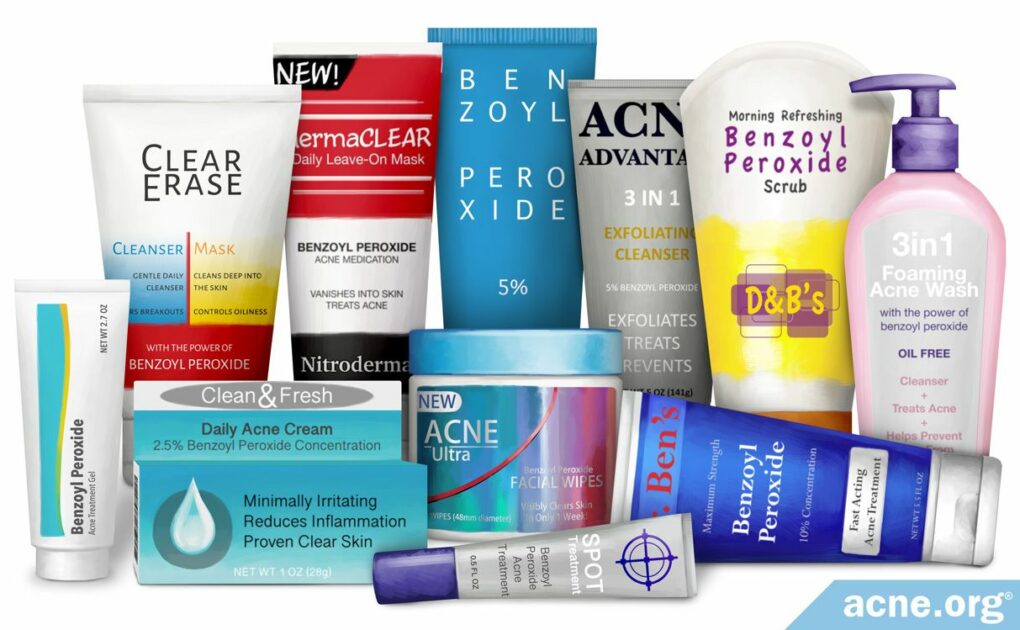Benzoyl Peroxide Is a Topical Acne Medication That Kills Bacteria, Exfoliates the Skin, Reduces Inflammation, and Clears Clogged Pores

The Essential Info
Benzoyl peroxide is a common topical acne treatment that is found in both over-the-counter as well as prescription products with concentrations ranging from 2.5 – 10%.
How It Works:
- Eradicates bacteria: It kills over 99% of bacteria almost immediately.
- Exfoliates the skin: It is a drying agent that helps keep the skin turning over.
- Reduces inflammation: This is not yet proven, but is likely.
- Clears clogged pores: It helps unclog pores and prevents new clogs.
Side Effects:
It takes approximately one month for the skin to become accustomed to benzoyl peroxide, and dermatologists refer to the discomfort during this initial time period as the “hardening effect” of benzoyl peroxide. This is why it is important to start with only a pea-size amount of benzoyl peroxide once per day for the first week, and only then begin slowly ramping up the dosage and frequency.
Side effects include:
- Redness
- Dryness
- Peeling
- Burning
- Itching
- Contact dermatitis (a red, itchy rash), especially in the first few weeks of use
Even after the hardening effect subsides, benzoyl peroxide will continue drying the skin, so a moisturizer should be used after each benzoyl peroxide application. Look specifically for a moisturizer that contains “tocopheryl acetate” on the ingredient list.
How to Get Benzoyl Peroxide to Work Its Best: Studies show benzoyl peroxide clearing the skin by approximately 50%, however, when used within a proper regimen, it reliably and completely clears the skin in just about everyone. A proper regimen consists of using 2.5% benzoyl peroxide and slowly ramping up the dosage so that after 1 month you are using a lot of it. Here are the full instructions to make sure benzoyl peroxide will completely clear you up.

The Science
What is Benzoyl Peroxide?
Benzoyl peroxide is a white, grainy/powdery substance that has been used in several industries since the early 20th century. The first time benzoyl peroxide was used as a medication was in 1905, when it was used as an antiseptic for wounds. After this, it continued to be used to treat a variety of conditions, including burns and leg ulcers.
Benzoyl peroxide was first used to treat acne in 1965 and since then has been increasingly relied on to treat acne, either alone or in combination with other anti-acne medications, such as retinoids (tretinoin, adapalene, tazarotene, trifarotene).
When used to treat acne today, benzoyl peroxide is found in both over-the-counter and prescription products at concentrations ranging from 2.5 – 10%.1-3
How It Works
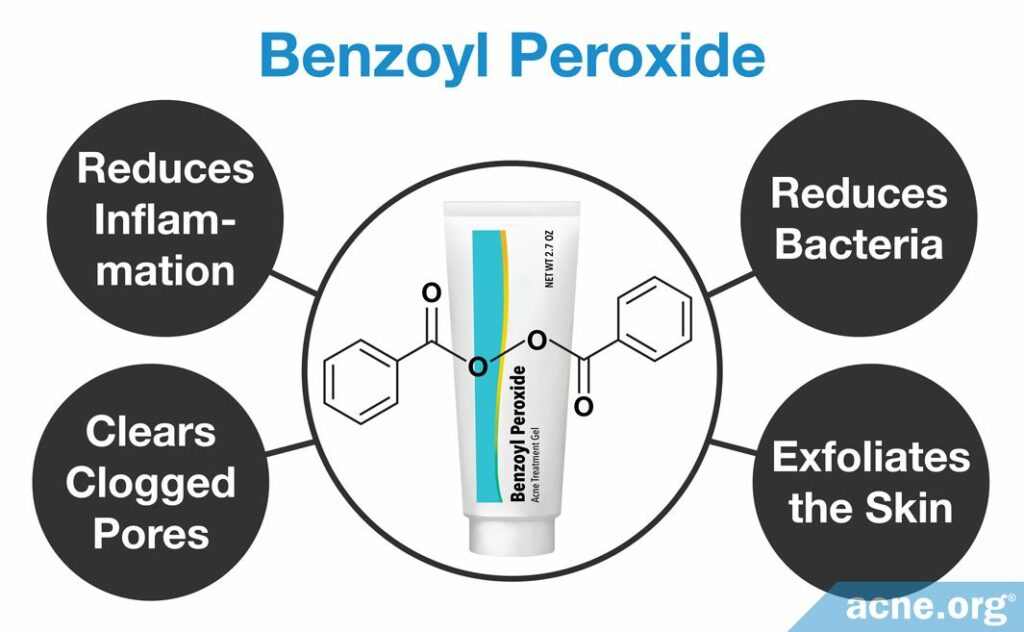
Benzoyl peroxide works in four ways to treat acne. It:
- Reduces bacteria: Benzoyl peroxide quickly absorbs into the skin, where it kills 99.9% of bacteria almost immediately. In acne, a bacteria known as C. acnes grows inside acne lesions.
- Reduces inflammation: By killing bacteria, benzoyl peroxide may reduce inflammation inside acne lesions.
- Exfoliates the skin: Benzoyl peroxide functions as a peeling agent by drying the skin and helping skin cells flake off. This helps to prevent pores from becoming clogged and leading to acne lesions.
- Clears clogged pores: Some chemicals dissolve in water and others dissolve in oil. Benzoyl peroxide dissolves in oil. This is important because skin pores are filled with skin oil, and benzoyl peroxide can therefore penetrate into pores, where it can then work to kill bacteria and unclog the pore.4
How Effective Is It?
Several studies report significant effectiveness of 50% or more. However, since 50% isn’t good enough, it is important to use benzoyl peroxide properly to up its chances to completely clear the skin. When used properly and applied generously (after an initial ramp-up phase), it can completely clear acne.
Expand to read studies on benzoyl peroxide efficacy
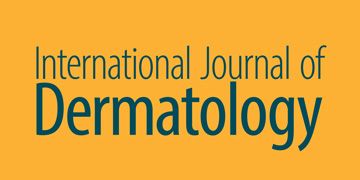
A 1986 study published in the International Journal of Dermatology compared the efficacy of a 2.5%, 5%, and 10% concentration of benzoyl peroxide to treat mild-to-moderate facial acne in 153 acne patients over the course of eight weeks. After eight weeks, the researchers examined how well each of the benzoyl peroxide formulations decreased inflammatory acne lesions, such as papules, pustules, nodules, and cysts. They found that:
- The 2.5% concentration reduced the number of inflammatory acne lesions by 50.9%
- The 5% concentration reduced the number of inflammatory acne lesions by 57.7%
- The 10% concentration reduced the number of inflammatory acne lesions by 44.7%
They also found that the side effects of benzoyl peroxide, which include burning, redness, and skin peeling, are worse after using the 10% concentration than they were after using the 2.5% or 5% concentrations. The study concluded, “[A] lower concentration of benzoyl peroxide should be useful for treating patients with easily irritated skin.”5
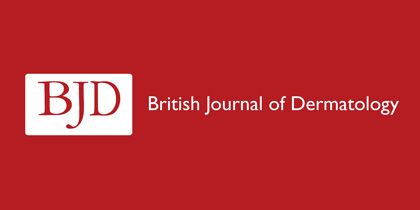
A 1988 study published in the British Journal of Dermatology compared the efficacy of benzoyl peroxide to that of clindamycin phosphate, which is a common topical antibiotic used in the treatment of acne. To perform this study, the researchers divided a group of 60 patients with mild-to-moderate acne into two groups: one group used benzoyl peroxide, and the other used clindamycin phosphate daily for 4 months. The study found that after 4 weeks of treatment, benzoyl peroxide caused a 66.7% reduction in acne lesions, and clindamycin phosphate caused a 59.1% reduction. However, after 12 weeks of treatment, benzoyl peroxide caused a 59.8% reduction in acne lesions, while clindamycin phosphate only caused a 34.4% reduction. They also found that benzoyl peroxide decreased skin oiliness, and caused skin peeling, while clindamycin phosphate did not impact skin oiliness but caused less skin peeling than benzoyl peroxide.6
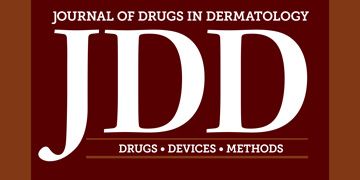
A 2009 review published in the Journal of Drugs and Dermatology examined a study that compared the efficacy of 3% benzoyl peroxide to that of 5% benzoyl peroxide combined with an antifungal agent. The researchers found that the 3% benzoyl peroxide treatment reduced the number of acne lesions by 16%, while the combination of 5% benzoyl peroxide and antifungal agent reduced acne lesions by 64%. Therefore, the researchers concluded that the combination of benzoyl peroxide with an antifungal agent may be as effective as combinations of benzoyl peroxide and antibiotics like clindamycin phosphate at treating acne. This is beneficial in acne treatment because an antifungal agent may be better tolerated than antibiotics.7
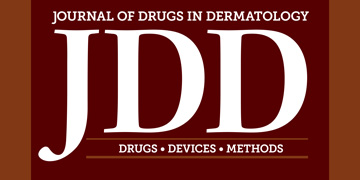
A 2009 review published in the Journal of Drugs and Dermatology examined a study that compared the efficacy of combining 6% benzoyl peroxide with 0.1% tretinoin, which is a retinoid that is commonly used for the treatment of acne. After 12 weeks of treatment, the researchers found that the combination of tretinoin and benzoyl peroxide cleared acne much better than tretinoin on its own. Therefore, they deemed the combination of benzoyl peroxide and tretinoin effective at treating acne.7
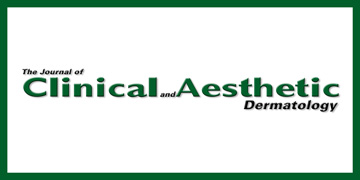
A 2021 study published in The Journal of Clinical and Aesthetic Dermatology compared the efficacy of 2.5% benzoyl peroxide used alone to 2.5% benzoyl peroxide used together with 5% niacinamide for treating mild-to-moderate acne. The researchers divided 21 patients into two groups: one group used benzoyl peroxide alone, and the other used benzoyl peroxide together with niacinamide twice daily for 12 weeks. The researchers found that after 12 weeks, patients who had used benzoyl peroxide by itself experienced a 34% reduction in non-inflammatory acne lesions and a 54% reduction in inflammatory acne lesions. By contrast, patients who had used benzoyl peroxide together with niacinamide experienced a 51% reduction in non-inflammatory acne lesions and a 73% reduction in acne lesions. In other words, while benzoyl peroxide alone was effective against acne, adding niacinamide further improved the treatment results.8
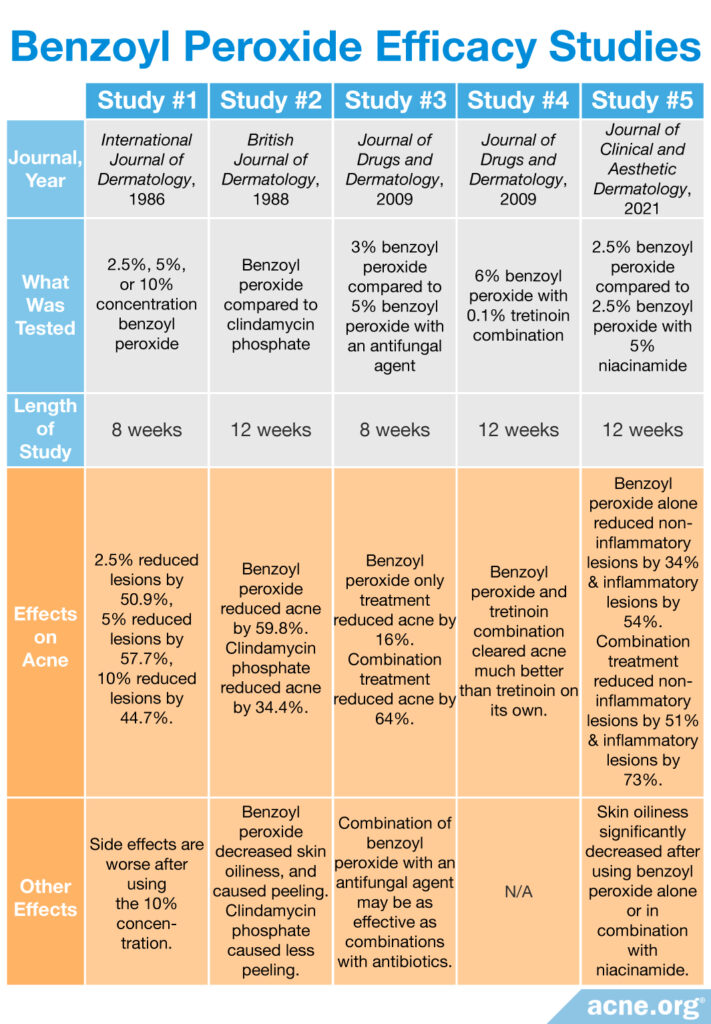
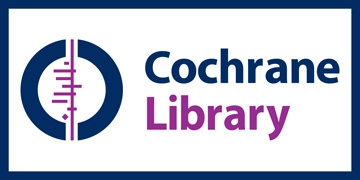
In 2020, researchers performed a systematic review of all available evidence by combing through 120 studies on benzoyl peroxide and acne. They published their findings in the Cochrane Database of Systematic Reviews.
The studies included a grand total of 29,592 males and females with mild-to-moderate acne. The authors of the review came to the conclusion that benzoyl peroxide appears to be effective against mild-to-moderate acne and works about as well as the topical retinoid adapalene or the topical antibiotic clindamycin, two other common acne treatments.9
When it comes to severe acne, two studies have found that a combination topical treatment consisting of 0.3% adapalene and 2.5% benzoyl peroxide was effective in treating severe acne and reducing the formation of acne scars.10,11
One study also found that a combination treatment consisting of 0.15% adapalene, 3.1% benzoyl peroxide, and 1.2% clindamycin phosphate was effective in treating moderate-to-severe acne.12
Details of Studies on Benzoyl Peroxide Efficacy in Severe Acne
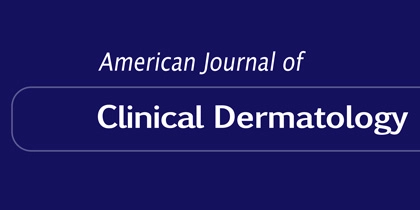
The first study was published in the American Journal of Clinical Dermatology in 2016. A total of 503 people with acne participated in the study. One-half of the participants suffered from moderate acne, and the other half had severe acne. The researchers divided the participants into 3 groups:
1. Group 1: This group included 217 participants who received a gel consisting of 0.3% adapalene and 2.5% benzoyl peroxide.
2. Group 2: This group included 217 participants who received a weaker gel consisting of 0.1% adapalene and 2.5% benzoyl peroxide.
3. Group 3: This group included 69 participants who received a placebo gel with no medicinal ingredients.
Each group applied the gel to the skin once a day for 12 weeks. At the end of this period, the researchers looked for improvements in acne in each group. They found that participants in Group 1, who received the 0.3% adapalene/2.5% benzoyl peroxide gel, experienced an acne improvement of 33.7%, significantly more than those in Group 3 who received the non-medicinal gel.
The researchers also noted that for participants with severe acne, the 0.3% adapalene/2.5% benzoyl peroxide gel produced a significant improvement, while the lower-dose 0.1% adapalene/2.5% benzoyl peroxide gel did not.10

The second study was published in the same journal in 2018. This study tested a combination adapalene-benzoyl peroxide gel on 67 patients with moderate-to-severe acne and acne scars. Each patient received two gels:
1. Treatment gel: A 0.3% adapalene/2.5% benzoyl peroxide gel
2. Placebo gel: A similar-looking gel lacking any medicinal ingredients
The patients were randomly assigned to apply the treatment gel to either the right or left half of the face and the placebo gel to the other half of the face every day for 24 weeks. At the end of this period, the researchers looked for improvements in acne and/or acne scars. They found that 64% of patients experienced either a complete or near-complete clearing of acne on the side of the face treated with adapalene/benzoyl peroxide. In contrast, the side treated with the placebo gel cleared or nearly cleared in only 19% of patients.
When it comes to acne scars, the number of acne scars decreased modestly by 16% on the side of the face treated with adapalene/benzoyl peroxide, and increased by 14% on the side treated with the placebo gel. The researchers wrote, “Topical [0.3% adapalene/2.5% benzoyl peroxide] prevented and reduced [indented] scar formation.”11
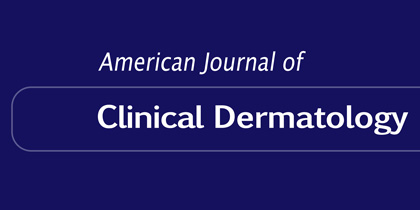
The third study was published in the American Journal of Clinical Dermatology in 2022 and tested a combination clindamycin-adapalene-benzoyl peroxide gel on 741 patients with moderate-to-severe acne. The patients were divided into 5 groups, each of which received different combinations of the three medicinal ingredients:
- Group 1: This group included 147 participants who received a gel consisting of all three ingredients—1.2% clindamycin phosphate, 3.1% benzoyl peroxide, and 0.15% adapalene.
- Group 2: This group included 150 participants who received a gel consisting of 3.1% benzoyl peroxide and 0.15% adapalene.
- Group 3: This group included 146 participants who received a gel consisting of 1.2% clindamycin phosphate and 3.1% benzoyl peroxide.
- Group 4: This group included 150 participants who received a gel consisting of 1.2% clindamycin phosphate and 0.15% adapalene.
- Group 5: This group included 148 participants who received a placebo gel without any medicinal ingredients.
Each group applied the gel to the skin once a day for 12 weeks. At the end of this period, the researchers looked for improvements in acne in each group. They found that 52.5% of patients in Group 1, who received the gel containing all three ingredients, experienced either a complete or near-complete clearing of acne. In Groups 2 and 3, which received a gel containing benzoyl peroxide and one other ingredient, just over a quarter of patients experienced a complete or near-complete clearing of acne. Interestingly, all the treatments that included benzoyl peroxide (Groups 1-3) were somewhat more effective at reducing non-inflammatory acne lesions than inflammatory lesions. The researchers concluded that a single gel that included benzoyl peroxide as well as a topical antibiotic and topical retinoid may be effective against acne and simple for patients to use.12
Side Effects
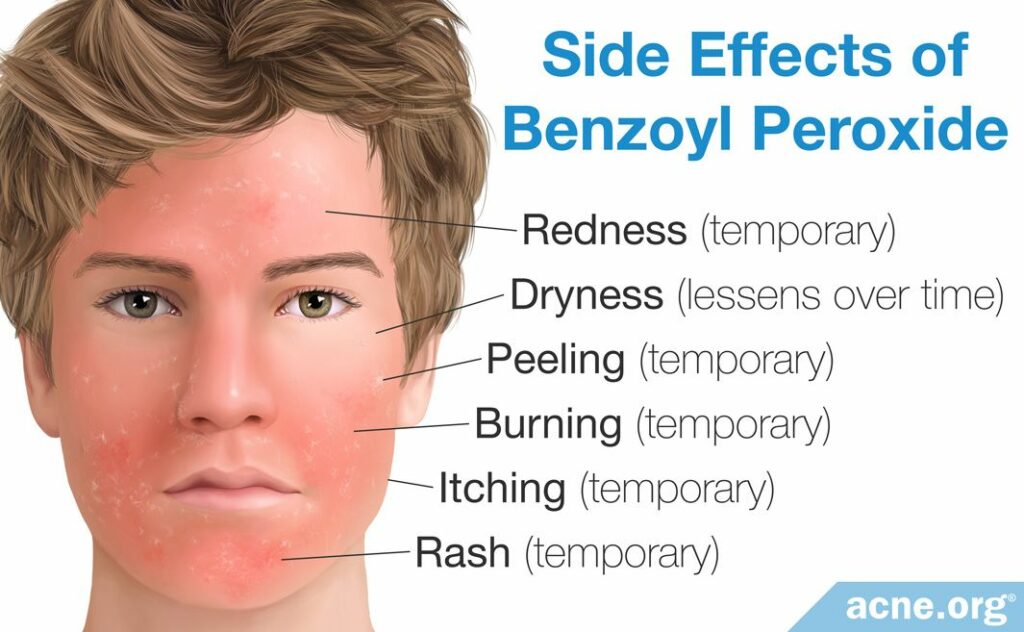
The most common side effects associated with benzoyl peroxide are:
- Redness
- Dryness
- Peeling
- Burning
- Itching
- Contact dermatitis – a red, itchy rash (in 1 – 2.25% of people)
These side effects occur within the first few weeks of treatment, and dramatically subside after a few weeks of use.2,4
When using benzoyl peroxide, it’s important to start slowly, using only a pea-sized amount of benzoyl peroxide and only using it once a day for the first week to limit these side effects. Then, you can move to twice a day application and slowly ramp up your dosage of benzoyl peroxide so that after 1 month you are using a generous amount of benzoyl peroxide to adequately clear the skin.
Pregnancy: When it comes to using benzoyl peroxide during pregnancy, the U.S. Food and Drug Administration (FDA) has classified it as a Category C drug, which means that its effects on the health of the fetus are unknown.13 However, doctors generally consider benzoyl peroxide safe to use during pregnancy because very little of it is absorbed into the blood. If you are pregnant, always check with your doctor before using any medication.
Benzoyl Peroxide Can Prevent Antibiotic Resistance
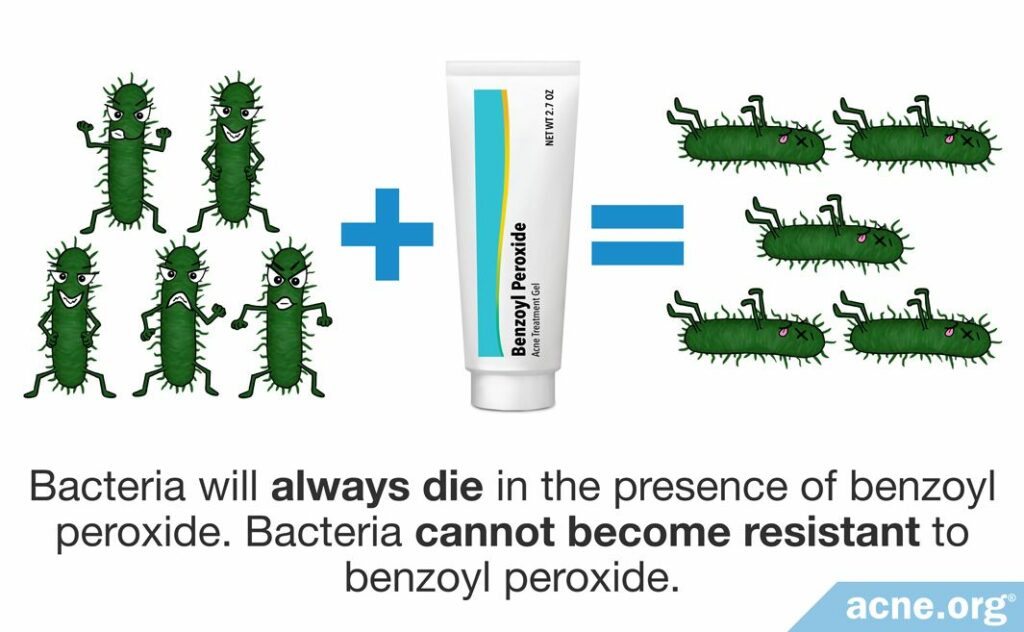
With antibiotics, bacteria can develop resistance, which means that all the bacteria are not killed by the antibiotic, and it becomes less effective over time. Benzoyl peroxide does not cause antibiotic resistance.
Researchers have found that when benzoyl peroxide is used in combination with the antibiotic, clindamycin phosphate, there is 1600% less resistant bacteria than when clindamycin is used on its own. This means that using benzoyl peroxide with antibiotics helps to protect against the development of bacterial resistance.
However, it is controversial to use benzoyl peroxide with antibiotics because benzoyl peroxide is usually far better at treating acne than antibiotics, and it does not come with many of the serious and distressing side effects that antibiotics cause.7,14 In other words, just because benzoyl peroxide reduces the harm of antibiotics, it does not mean antibiotics should be used in the first place.
References
- Sagransky, M., Yentzer, B. A. Feldman, S. R. Benzoyl peroxide: a review of its current use in the treatment of acne vulgaris. Expert Opin Pharmacother 10, 2555 (2009). https://www.ncbi.nlm.nih.gov/pubmed/19761357
- Cotterill, J. A. Benzoyl peroxide. Acta Derm Venereol 89, 57 – 63 (1980). https://www.ncbi.nlm.nih.gov/pubmed/6162349
- Kraus, A. L. et al. Benzoyl peroxide: an integrated human safety assessment for carcinogenicity. Regul Toxicol Pharmacol 21, 87 – 107 (1995). https://www.ncbi.nlm.nih.gov/pubmed/7784640
- Dutil, M. Benzoyl peroxide: enhancing antibiotic efficacy in acne management. Skin Ther Lett 15, 5 – 7 (2010). https://www.ncbi.nlm.nih.gov/pubmed/21076800
- Mills, O. H. et al. Comparing 2.5%, 5%, and 10% benzoyl peroxide on inflammatory acne vulgaris. Int J Dermatol 25, 664 – 667 (1986). https://www.ncbi.nlm.nih.gov/pubmed/2948929
- Swinyer, L. J. et al. A comparative study of benzoyl peroxide and clindamycin phosphate for treating acne vulgaris. Br J Dermatol 119, 615 – 22 (1988). https://www.ncbi.nlm.nih.gov/pubmed/2974719
- Fakhouri, T., Yentzer, B. A. & Feldman, S. R. Advancement in benzoyl peroxide-based acne treatment: methods to increase both efficacy and tolerability. J Drugs Dermatol 8, 657 – 661 (2009). https://www.ncbi.nlm.nih.gov/pubmed/19588642
- Kaewsanit, T., Chakkavittumrong, P. & Waranuch, N. Clinical comparison of topical 2.5% benzoyl peroxide plus 5% niacinamide to 2.5% benzoyl peroxide alone in the treatment of mild to moderate facial acne vulgaris. J Clin Aesthet Dermatol 14, 35-41 (2021). https://pubmed.ncbi.nlm.nih.gov/34804354/
- Yang, Z., Zhang, Y., Lazic Mosler, E., Hu, J., Li, H., Zhang, Y., Liu, J. & Zhang, Q. Topical benzoyl peroxide for acne. Cochrane Database of Systematic Reviews 3, CD011154 (2020). https://www.cochranelibrary.com/cdsr/doi/10.1002/14651858.CD011154.pub2/full
- Stein Gold, L., Weiss, J., Rueda, M. J., Liu, H. & Tanghetti, E. Moderate and severe inflammatory acne vulgaris effectively treated with single-agent therapy by a new fixed-dose combination adapalene 0.3 %/benzoyl peroxide 2.5 % gel: A randomized, double-blind, parallel-group, controlled study. Am J Clin Dermatol 17, 293-303 (2016). https://pubmed.ncbi.nlm.nih.gov/26945741/
- Dréno, B., Bissonnette, R., Gagné-Henley, A. Prevention and reduction of atrophic acne scars with adapalene 0.3%/benzoyl peroxide 2.5% gel in subjects with moderate or severe facial acne: Results of a 6-month randomized, vehicle-controlled trial using intra-individual comparison. Am. J. Clin. Dermatol. 19, 275-286 (2018). https://pubmed.ncbi.nlm.nih.gov/29549588/
- Stein Gold, L., Baldwin, H., Kircik, L. H., Weiss, J. S., Pariser, D. M., Callender, V., Lain, E., Gold, M., Beer, K., Draelos, Z., Sadick, N., Pillai, R., Bhatt, V. & Tanghetti, E. A. Efficacy and safety of a fixed-dose clindamycin phosphate 1.2%, benzoyl peroxide 3.1%, and adapalene 0.15% gel for moderate-to-severe acne: A randomized Phase II study of the first triple-combination drug. Am J Clin Dermatol 23, 93-104 (2022). https://pubmed.ncbi.nlm.nih.gov/34674160/
- Matin, T. & Goodman, M. B. Benzoyl Peroxide. [Updated 2020 Mar 16]. In: StatPearls [Internet]. Treasure Island (FL): StatPearls Publishing; 2020 Jan-. Available from: https://www.ncbi.nlm.nih.gov/books/NBK537220/
- Harper, J. C. Benzoyl peroxide development, pharmacology, formulation and clinical uses in topical fixed-combinations. J Drugs Dermatol 9, 482 – 487 (2010). https://www.ncbi.nlm.nih.gov/pubmed/20480791
